Check your inboxes!
This is a good one, people! We’ve got a Kinetic update, a book announcement, opportunities for writers to sell a script (if you’ve got a holiday screenplay), we’ve got the hardest Consultation Deal trivia question, maybe, ever. I talked to a professional screenwriter about his eight year journey of selling a script. I review a BANANAS action screenplay that has the single most expensive set piece I’ve ever read. So yeah, if you’re not already on my mailing list, this is definitely the month to hop on. E-mail me at carsonreeves1@gmail.com and I’ll send the newsletter over. And yes, everybody who signs up receives the dog in the photo.
LABOR DAY DEAL! – I’m taking $200 off my screenplay consultations if you order them this weekend! If you want to get super cheap notes now or on a future script, e-mail me at Carsonreeves1@gmail.com. Use subject line “Labor Day” and let’s rock n’ roll!!
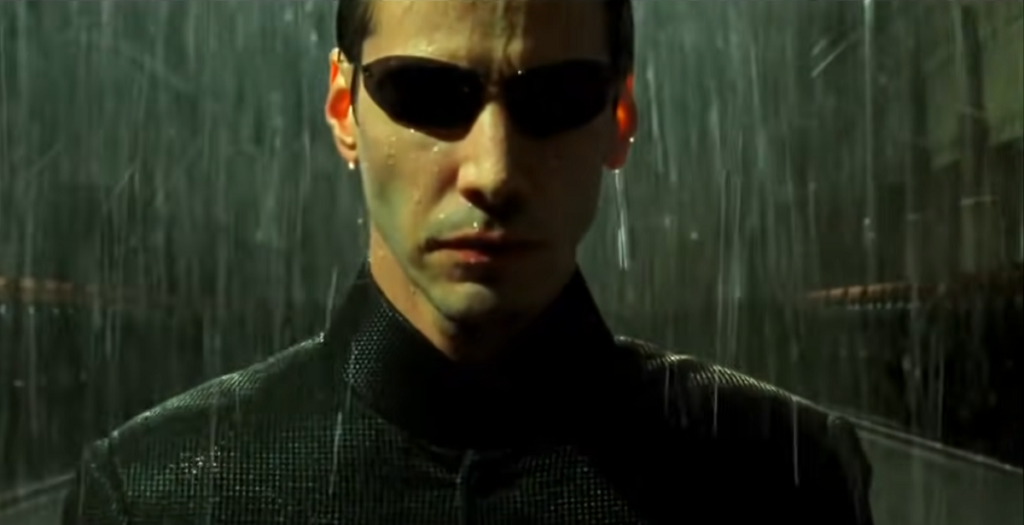 I just like putting up Matrix pictures. This has nothing to do with the article.
I just like putting up Matrix pictures. This has nothing to do with the article.
Just like when I review a script on the site, I have “what I learn” moments when I do script consultations as well. Of course, most of these things, I’ve already learned. But if there’s one thing I’ve come to realize about screenwriting, it’s that you occasionally need to be reminded of things.
Which was the motivation for today’s article. I thought it would be fun to share the big lesson I learned (or, was reminded of) in each of the last ten script consultations I did. It’s going to be a little tricky because I can’t share the details of the scripts. But if I need to get detailed, I’ll just adjust the concept and specifics to keep everything private.
Afterwards, I’ll provide you with a ranking of how often I come across this particular issue in screenplays. 1/10 means I barely come across it. 10/10 means it’s one of the biggest issues in all of screenwriting. Okay let’s get into it!
1) Fear of being on-the-nose – For an airplane pilot, the scariest thing that can happen is that all of your engines go out mid-flight. For a surgeon, the scariest thing that can happen is that the patient goes into cardiac arrest during the surgery. For a screenwriter, the scariest thing that can happen is someone telling you that your script is on-the-nose. We actively avoid “on-the-nose” to such a degree that we actually create the opposite problem for ourselves, which is that the specifics of our plot, characters, and theme are so vague that the reader has no idea they’re even there. For example, if you wanted to build the flaw of “selfishness” into your main character, but were so terrified of being on-the-nose you only mentioned the selfishness a couple of times in the script, then when that character transforms in the end and becomes selfless, we’re utterly confused. Cause we never knew the character was selfish in the first place. — In my experience, the writers who are obsessive about avoiding on-the-nose moments are being too vague in general. It’s okay to draw attention to things that are important in your script.
How often I run across this issue: 5 out of 10
2) Picking the wrong point-of-view – Sometimes when you write a script, the hero is obvious. If you’re writing “John Wick,” for example, you know whose eyes the movie should be seen through. But sometimes you run into scenarios that have more characters, a less linear storyline, and, therefore, it isn’t as clear whose point-of-view should take precedence. For example, if you have a movie like Knives Out, where there are all sorts of characters to choose from, you have to think harder about which character the spotlight should be on. The answer is typically the person who’s the most active. So, in a movie like that, the detective is the most active. But you also have to take into account which character has the most interesting storyline. That will play into whose POV to follow as well. In this particular consultation script, I was posed with one character – let’s call her “the killer” – whose kills made her somewhat interesting to watch and another character – let’s call him “the detective” – who had the more active storyline, since he was investigating these murders. An argument could be made to go with either character. But I felt that the benefits from the discoveries that would come from the detective’s investigation outweighed watching the killer, whose killings wasn’t interesting enough to be the sole focus of the story. The killer wasn’t Patrick Bateman from American Psycho, for example. POV can be a difficult decision to make in some scripts. But when it’s all said and done, go with the person whose POV leads to a more entertaining story.
How often I run across this issue: 5 out of 10
3) Execution is too familiar – No matter how many scripts we write, a pitfall we’re never safe from is being too formulaic with our execution. And there’s a specific reason for this. When we fell in love with a particular genre growing up, we fell in love with everything about it. We fell in love with the characters, the scenarios, the dialogue, the plot twists. And so when the time came to write these scripts ourselves, we wanted to do what we saw growing up!! We wanted to write those same characters. We wanted to write those same scenes. And some weird cognitive dissonance didn’t allow us to realize this was a bad thing – that readers were going to tell us that our scripts were formulaic and cliche. To combat this, you need to deconstruct the genre on some level and actively avoid writing the characters and scenarios and dialogue you were so fond of. You’re still going to write those things to a degree. But you’re actively looking to write your version of it and not just straight up copy and paste.
How often I run across this issue: 8 out of 10
4) Way too much going on – There are two primary reasons why someone might label your script this way. One, you have too many characters. Or two, you have too much plot. But, by far, the worst violations of this rule are when you do both. You have way too much plot – you’re jumping around to a million different locations and trying to cram in too many storylines. And, by proxy, because you have all this extra plot, you populate it with more charters than your story can handle. Reading these scripts is like reading college textbooks. They’re big and cumbersome and feel like you’re taking notes as opposed to enjoying yourself. I think the reason writers make this mistake is because they have the wrong mindset. Their mindset is, “I have all this stuff to get into my story. How can I best position my story to squeeze it all in?” And since that’s the objective, they feel really good when they’ve done it. It’s like, “Wow! I was able to get every single thing I wanted into the script.” The objective should instead be, “How can I write the most entertaining story?” If you start from there, you probably won’t ever get this criticism thrown at you.
How often I run across this issue: 9 out of 10
5) Rules of your world are too complicated – This is an issue I run into almost exclusively in the sci-fi and fantasy genres. This is your mythology. This is your world-building. And what’s great about that is, when you get it right, it’s awesome. The Matrix is awesome. The rules are cool and fun to learn. But there’s a version of The Matrix where there are 20 more rules about how things work. Where there is three times as much backstory. Where there is so much exposition, it starts to contradict itself. Time travel scripts, in particular, can become incomprehensible if you don’t simplify your rule-set. I remember I wrote a time travel script once and I must’ve had a dozen time travel rules that I thought were expertly crafted. I felt that if anyone had me in a room and challenged me on these rules, that in just under an hour, I would be able to convince them that it all worked and made sense. It probably took me another five years before I realized how stupid that was. That the goal is not to be able to prove your point. Your goal is always (always always always) to entertain the reader. Period. This is a reminder to everyone writing sci-fi and fantasy to err on the side of LESS IS MORE. I know you want to show us how intricate your multiple universe time-travel rule-set is. But movies don’t have the capacity to keep track of all of that. You need to distill it down to the essentials.
How often I run across this issue: 5 out of 10 (but would be 8 out of 10 if this was just an assessment of sci-fi and fantasy scripts)
6)An unimportant subplot – Whenever we sit down to construct our latest screenplay, we tend to have a number of things we want to put in the script. Because these become the “OG” elements of your screenplay, you become attached to them. You think they are unchangeable. It’s sort of like laundry on your bedroom floor. The longer it sits there without you picking it up, the more it starts to feel like a permanent part of the room. This can lead to subplots that aren’t necessary for your story sticking around, draft after draft. In this particular script there was a subplot with a character that was only peripherally connected to the main plot. So, whenever we visited this character, we felt like we were a million miles away from the main story. It can be hard to ditch these subplots. But if a subplot isn’t helping push the story forward, it’s probably not important. Even if that subplot is helping develop your main character, it probably needs to go. 95% of screenplays move too slowly. Unnecessary subplots are a big reason for that.
How often I run across this issue: 4 out of 10
7)Over-setting up the first act – This is an adjacent tip to number 4. First acts are tough because they’re the setup act. They set up the main character, the supporting characters, and the plot. When your stories are simple, like Taken, this is easy-peasy. But when your stories are complex, like Avengers Infinity War, it can be a lot tougher. Because you just have a lot of stuff you’ve gotta cram into that opening act. But, in the case of this consultation, the story was relatively simple, yet the writer tried to include way too much in the first act. For example, instead of just telling you what the main character was up to in their life, they tried to include another 40 years of their backstory. And then, as soon as that happened, we had a death to deal with, and then a funeral to deal with, and then a will reading to deal with. Why not just open with the will reading? As I like to remind screenwriters any chance I get, the most common mistake I see is writers making things overly complex. The solution to most problems in screenwriting is keep it simple.
How often I run across this issue: 5 out of 10
8) Concept isn’t big enough – A concept must be special. As in, this is something we don’t typically get to see and therefore is worthy of making a movie about. And the stakes need to be high. The story must feel like it matters. My primary issue with this consultation script was that the story felt too small. I needed the stakes to be bigger. If you ever want to see what it looks like when concepts aren’t big enough, check out the tail end of the 1990s – early 2000s indie era. This is when writers were getting super experimental, and, in the process, writing a bunch stories that had low stakes and no compelling central idea. A couple of films that come to mind are Gerry, a movie that has Matt Damon and Casey Affleck roaming around a desert for 90 minutes. And Bubble, from Steven Soderbergh, which was about a doll machine plant. You can still make these movies if you direct them yourself and keep the budget low. But it’s hard to compete on the spec script market with a low-stakes or medium concept script.
How often I run across this issue: 7 out of 10
9)Starts off fast, loses momentum – We seem to be aware of three important checkpoints once we get into screenwriting. The first 5 pages, the first 10 pages, and the first act. We know we need to make these segments of the script sing. Cause we need to get people into our script if we expect them to finish our script. Unfortunately, this leads to an oft-overlooked side effect, which in that we don’t write with the same level of immediacy after the first act. Granted, you can’t make every single moment in your script thrilling. But you should still have that mindset of, “The writer could be getting bored. The writer could be getting bored.” So that you continue to write an entertaining script the whole way through. This particular script started out like gangbusters. But the writer took his foot off the gas about 15 pages into the second act. And it took what was, up until that point, an ‘impressive’ script, and turned into just barely ‘worth the read.’ So don’t take your foot off the gas, people!
How often I run across this issue: 8 out of 10
10)Being too clever for your own good – Sometimes I come across really smart writers who are so driven to write something great that they forget to write something good. In other words, they unnecessarily overwrite their script. This particular script was a mystery and it was just so insanely detailed and had so many little clues and key moments along the way, along with voice overs and flashbacks and voice over from past characters playing over present storylines. It was so intricate that by the time we got to the ending, I was trying to see the story through thirteen layers of intricate plotting and therefore struggled to understand what happened. In the Sixth Sense, we get it right away that Bruce Willis is dead. If you try to overcomplicate that setup and the reveal, it doesn’t work. I’m not going to give you the advice to “dumb it down.” But writers who try to outthink everyone… you don’t need to outthink us as much as you think you do. Which brings me right back to my most common screenwriting advice: Keep it simple!
How often I run across this issue: 2 out of 10
LABOR DAY DEAL! – I’m taking $200 off my screenplay consultations if you order them this weekend! If you want to get super cheap notes now or on a future script, e-mail me at Carsonreeves1@gmail.com. Use subject line “Labor Day” and let’s rock n’ roll!!
Genre: Comedy
Premise: When a misogynist explorer meets his sudden (and violent) end, his long-overlooked understudy seizes the moment and embarks on an adventure that will earn her a place in the annals of history.
About: Matt Roller is a seasoned TV writer who comes from the Dan Harmon tree, writing on both Rick and Morty and Community. This script landed him on last year’s Black List. Also, Tristar purchased the script last year.
Writer: Matt Roller
Details: 108 pages
 Annie Murphy for Abbi?
Annie Murphy for Abbi?
Abbi and The Eighth Wonder hooked me almost instantly with this line, which happens after studly explorer and proud misogynist, Channing Smith, bumps into our heroine in the jungle while they’re being chased by cannibalistic locals: “I thought they got you when I pushed you in front of me and ran.”
“Nope. Still alive,” our hero, Abbi, replies.
“That’s good news for both of us. I may need a decoy. I don’t understand how that damn Goldblum found us.”
“I did mention we weren’t covering our tracks. Also you left our map in that bar. Bragged to a lot of people about where we were going…”
“Yeah, he’s cunning.”
But Abbi and the Eighth Wonder makes a critical mistake not long after we meet our heroes that reverberates throughout the script. It’s a common choice a screenwriter will face whenever writing a two-hander. And, therefore, learning from it could help save your script in the future.
It’s 1936 and Abbi Rhodes is the assistant to world-traveling explorer, Channing Smith. As we’ve established, Channing is kind of a sexist d#*%head. A woman, in his mind, is someone who will always be an assistant, never an explorer.
He’s been able to string Abbi along precisely because he’s promised to one day make her an explorer. So during a big celebration party after Channing’s latest successful adventure (where Abbi did all the work), Abbi presses Channing on when he’s going to introduce her to the Council of Explorers when – KABOOM! – Channing is blown up by an exploding cannonball he was playing with.
At Channing’s funeral, Abbi meets Jo, a gossip journalist who wants to be a real journalist. Her only problem is that she hates everyone and drinks too much. But much like Abi, she’s tired of men getting all the cool jobs. And when Abbi gets a hold of a rare medallion that is said to be the key to finding the eighth wonder of the world, Jo wants in.
So the two head down to South America to look for a suitcase that is said to have the famed map leading to Firebeard’s treasure (aka ‘the eighth wonder of the world’). There they run into Adam Blaze, the evil male explorer who has dutifully filled in in the absence of Channing. Oh, but Abbi and Jo are about to get the surprise of a lifetime. That’s because Channing is still alive! He faked his exploding death and is now teamed up with Adam to find the Eighth Wonder!
The two teams fight on trains, bi-planes, and inside lavish parties, before making their way to an island that has Firebeard’s treasure. All parties will have to navigate a pirate ship graveyard to locate the single most lavish treasure known to history. Will Abbi prove that she’s worthy of being a true explorer? Or will she fail, confirming that once an assistant, always an assistant?
First off, this is a funny script.
However, it could’ve been an awesome funny script.
And I think that the writer made a key mistake early on.
Abbi and Channing were hilarious together. Every exchange of theirs was funny. Him with his over-the-top sexist comments and her exasperatedly pointing out how wrong he was with every single decision he made. They were perfect together.
Then they killed Channing off. And in comes Jo. Jo, meanwhile, isn’t nearly as funny as Channing. Channing was a very clear archetype, which is important in comedy. We need to know the type of person someone is to laugh at them. Jo, meanwhile, was a mix of conflicting ideas and was hard to pin down. She’s a feminist. But she’s also kind of a clueless ditz. So her actions didn’t quite line up with her label.
More importantly, when you put Abbi and Jo together, they weren’t funny. I wasn’t even sure what the dynamic was. For example, in the Marvel films, Captain America is the super serious “everything by the book” guy and Iron Man is the loosen-up sometimes you gotta improvise guy.
Establishing dynamic is critical to a two-hander working and the writer HAD TWO CHARACTERS WITH THE PEFECT DYNAMIC. Yet he destroyed it by killing off Channing in favor of Jo, who was, quite frankly, lame.
Why did he do this? I suspect the angle was to focus on women working together as sort of “feminism is awesome” creed. But the irony is that you’re able to get that message across much better if Abbi is teamed up with the world’s biggest chauvinist.
I realize that there’s a creative choice here. And there are pros and cons to each decision. But the rule that trumps everything is that the best dynamic in your movie should be the dynamic that’s on the screen the most. Abbi and Jo do not have the best dynamic. Not even close. Abbi and Channing do. So that’s the movie right there. Full stop. End of discussion.
Now, you may think this killed the script for me but it didn’t. The writer wrote a lot of funny scenes and a lot of funny characters. He’s so funny, in fact, that he makes up for this mistake. One of my favorite characters is Abbi’s love interest, Michael, who’s this openly beta magician-on-the-weekends map-maker who is perennially dealing with bouts of diarrhea. He’s so opposite of Channing and Adam, you can’t help but laugh.
This is both the curse and the benefit of writing comedy. If you’re funny, you can make up for major creative mistakes. But if you’re not funny, you can write the most technically perfect script ever and it won’t matter. In other words, even if Roller had paired Abbi up with Channing, it wouldn’t have mattered if he wasn’t naturally funny.
What is “funny?” What does that mean?
Well, obviously, “funny” is personal for every individual. But there just seems to be a little more imagination in people who are funny. For example, fellow misogynist explorer, Adam Blaze, is such a douchebag that, during big parties, he loves showing off his backflip, despite the fact that it’s the clumsiest backflip ever and he should not be proud of it at all.
Then, later on in the script, Abbi is about to steal the gold medallion from the museum, but a masked man is able to grab it before she can get her hands on it and he runs off. She chases him towards a busy street, effectively cornering him. “Who are you?” Abbi asks. “You’ll never know,” he says, deadly serious.
The “mysterious” masked man then proceeds to do the clumsiest backflip ever onto a passing truck bed.
It was just fun stuff like that that had me giggling the whole way through.
Whenever I post about a script I laughed at, I get a million comments declaring, “That’s not funny, Carson!!! You’re wrong!!!….. and DUMB!” All I have to say to that is, step into my shoes for a week. Read seven comedies that are truly TRULY not funny, and you might change your definition of funny. Because this writer is definitely funnier than the majority of comedy writers out there.
[ ] What the hell did I just read?
[ ] wasn’t for me
[x] worth the read
[ ] impressive
[ ] genius
What I learned: CRITICAL mistake. The writer did not give his two leads ages when they were introduced. I know that sometimes writers will do this at the request of the producers in order to cast a wider net of which actors they can send the script to. But you need to tell us Abbi’s age here. As any woman will tell you, their life at 25 is a lot different than their life at 35. And I didn’t know where, in that spectrum, Abbi’s age was. And it prevented me from truly understanding who she was as a person.
After just two episodes, is House of the Dragon the best show on television?
Genre: Fantasy
Premise: Six months after the death of the queen during childbirth, King Viserys deals with growing trouble on several fronts.
About: In its second weekend, House of the Dragon’s ratings actually went UP 2%. That’s extremely good news, considering that its ratings were so high with the premiere (10 million viewers). Normally, people will tune in to the premiere out of curiosity and a portion will decide, ‘not for me.’ To retain everyone shows just how strong the show is, particularly its writing.
Writer of this episode: Ryan J. Condal
Details: 54 minutes

Game of Thrones reminds me a lot of Star Wars in that it built its stellar mythology from whole cloth and took the world by storm with it. But like all great things, the show had to end at some point. And end it did.
When new Game of Thrones shows were announced to be in development, you thought, what’s the point? They can’t possibly be as good as the OG. I certainly didn’t think any spinoff could live up to the original.
Yet isn’t that exactly where we are? Staring down the barrel of a show that’s not only a worthy successor to Game of Thrones, but maybe even better than it??
You know where my mind goes in all of this. JEALOUSY! Why do G.O.T. fans get such an amazing follow-up to their geek shrine while we Star Wars nuts are left with clumsy half-baked scripts cobbled together by second-rate screenwriters scraped off the spice mines of Kessel.
Or, in layman’s terms: WHEN THE HECK DO WE GET OUR STAR WARS VERSION OF HOUSE OF THE DRAGON???
I suppose never.
Which may be okay, since House of the Dragon is slowly creeping up to becoming the best show on television and, you know what? I have no issues switching allegiances. I just want to watch good television.
So in episode 2, six months have passed and King Viserys is feeling the pressure to remarry cause the dude needs to have more babies! Even though he’s made his daughter, Rhaenyra, his successor, the hope is that he can get a wife, belt out a boy, and that way they can have a man as the successor instead of a woman. Can’t have no lady running things around here.
Everyone is strategizing for this rare opportunity to lift themselves up on the power hierarchy and the two contenders are Lord Corlys’s 12 year old daughter, and daughter of the King’s right hand man, 15 year old Alicent. Corlys’s daughter is the front runner but the King shocks everyone by choosing Alicent, who it also happens is Rhaenyra’s best friend. Rhaenyra is none too pleased by this development.
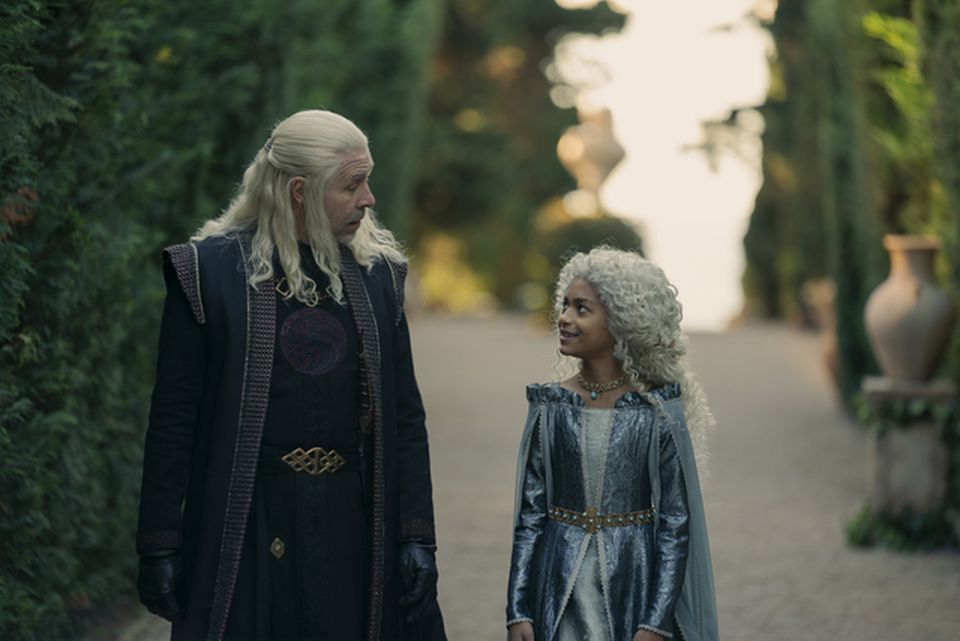 Lord Corlys’s daughter.
Lord Corlys’s daughter.
Meanwhile, the Targaryen’s control of the region is slipping. Some dude called the Crabfeeder, who feeds his captives to crabs, has taken over the Targaryen’s main shipping lanes, putting a strain on the kingdom’s coffers.
And let’s not forget about good old rabble-rouser, Daemon, who was so pissed off he didn’t win the succession title that he went off and created his own kingdom. If you can’t beat’em, leave’em. Recently, he’s stolen one of the Targaryen’s dragon eggs, a problem that must be remedied immediately, since Daemon with a dragon is the equivalent of handing nukes to Hitler.
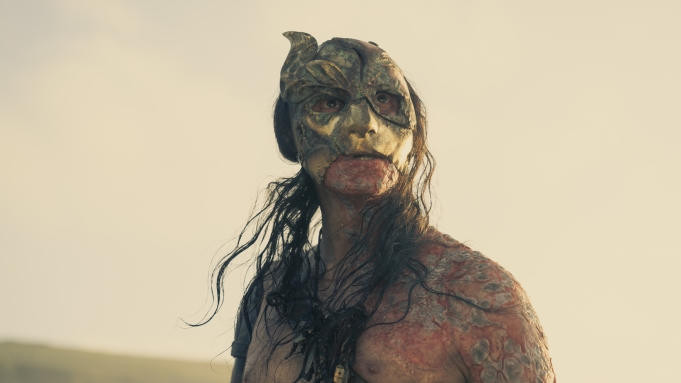 Crabfeeder?
Crabfeeder?
Things are heating up in Westeros!
As you know, I’m here for the screenwriting choices so let’s talk about them.
The major choice in the second episode was to jump forward six months. To the layman viewer, this is inconsequential. But to any screenwriter, they know this is a major creative decision. Most shows will make the storyline continuous as it’s much easier to manage.
I suspect that there are two main benefits to this choice. The first is that we needed time to pass after the queen’s death. Although we probably could’ve jumped right into the King remarrying, it makes more sense that he needed time to grieve.
But the far more obvious benefit is that they needed to introduce Daemon’s kingdom. If we would’ve moved the story along continuously, it would’ve taken all season to give Daemon a kingdom. This provides Viserys with an immediate threat, which is what you want in storytelling. You want there to be pressure bearing down on your protagonist from all angles.
It also looks like Viserys is going to have leprosy. His body is going to start falling apart (which is going to be gnarly and awesome) and that needs time to gestate. I loved the creepy little scene where he has to place his hand in maggots to eat away his rotting flesh.
What’s interesting is that the second episode basically makes the first episode a flashback. Unless they keep making giant jumps forward in time every episode, which I doubt. At some point, the story momentum you lose from a time jump becomes more detrimental than the narrative advantages you gain from a time jump.
It’s harder to do this sort of time-jumping in a feature. You can’t jump forward in time six months after one hour into a movie. I mean you can in specific instances. But, normally, you lose too much momentum. The main way movies are different from TV shows is urgency. Things need to happen RIGHT NOW in movies, which is why plots tend to move a lot quicker in features.
You don’t have that issue when telling a TV story, which allows you to make these bigger jumps in time if you so choose. Although I think this specific setting helps soften the impact of a time jump, which I’ll discuss later in the “What I Learned” section.
We talk a lot about pilot scripts on the site but we rarely talk about the screenwriting choices that go into a *second* episode. And this episode taught me that there is a key strategy you should be implementing in your second episodes which is thus: USE THEM TO SET UP YOUR SEASON’S BIG STORY THREADS.
This episode is setting up so many threads.
There are *plot* threads being set up: We have the crabfeeder issue. We have Daemon’s rogue kingdom. We have the king’s leprosy spreading. As well there are *character* threads being set up: Rhaenyra’s frayed friendship with Alicent due to her marrying her father. Lord Corlys’s weakening trust in Viserys. Vicerys inability to connect with his daughter.
Because the first episode must spend so much time introducing the characters and the world, it doesn’t have enough time to set up the season’s plot. So that’s what episode 2 is for. At least, in this series, that’s the case. But it was so successful that I would go so far as to say every TV writer should be doing this.
The only thing I’m worried about with this show is the writing of Rhaenyra. She’s not in the mix in any of the best scenes of the show. Granted, that’s somewhat due to her situation (being forced to wait in the wings). But it’s clear that the writers are struggling with her.
She has a scene where she’s picking a knight for a quest that, as far as I can tell, is inconsequential to the overall story. Then she has a talk with her friend, Alicent, in the candle room, that leaves next to zero impression on the show.
In her most memorable scene, Lord Corlys’s wife bullies her, telling her she’ll be an afterthought in the kingdom when all is said and done. But the character who comes out more memorable in that scene is the wife, not Rhaenyra.
Even her dragon moment is muted by the fact that she’s overshadowed by the dragon!
What’s sort of saved the writing of Rhaenyra so far is that the actress who plays her has a very interesting face. You’re always pulled in whenever you get a close-up of her. But it’s not due to the writing. It’s due to the actress.

If this show is going to be truly great moving forward, they need to figure out that character. And fast!
But it’s a minor quibble because so many of the other characters work and the season looks like it’s going to be very juicy. And not that disgusting kombucha juice either. I’m talking fresh-squeezed Westeros orange juice, baby. The creme de la juicy creme.
[ ] What the hell did I just watch?
[ ] wasn’t for me
[ ] worth the stream
[x] impressive
[ ] genius
What I learned: Period pieces are more forgiving of large time jumps. Time passing is a common theme when dealing with stories set in the far off past. So audiences are accepting of those time jumps. But I don’t think you can set a show in present day and get away with a six month time jump in episode 2. I just don’t think the audience would allow it.
 Emma Radacanu (last year’s winner)
Emma Radacanu (last year’s winner)
The next two weeks are two of my favorite weeks of the year.
That’s because the U.S. Open is on!!!
I fire up my wide-screen TV, turn on ESPN, and have luscious sweaty 4K bodies banging groundstrokes at each other in the background while I work.
Since I know you’re all dying to get my U.S. Open picks, here’s a quick preview of the tournament. This is Serena Williams’ last major tournament and, I’m afraid, she’s going to lose early. She’s just not in shape. So she can’t move to the ball fast enough to take on the top players. She might win a round. But she’ll be out by the second round for sure. With that said, her and her sister are playing doubles together. Since you don’t need to move as much in doubles, they might make a deep little run. I’d love to see that.
What’s so exciting about this U.S. Open is that there are no favorites on either side. If I had to bet, I would say that the Polish Punisher and number 1 seed, Iga Swiatek, will win the women’s tournament. But she’s far from a sure thing. Emma Raducanu, who won the tournament last year, has been disappointing since then and the whispers around the tour are that she’s a bigger one-hit-wonder than Devo.
On the men’s side, who the heck knows what’s going on. Djokovic is out because he’s not vaxxed. Medvedev has been playing stinky. Nadal is beat up and probably won’t make it to the second week. Wonder Boy, Alcaraz, who many are predicting will win double-digit grand slams, seems to have hit a plateau this season. The guy has the biggest forehand I’ve ever seen in my life but for whatever reason, he’s not unleashing it.
 Escape from Alcaraz
Escape from Alcaraz
I would love to see Kyrgios do well but he’s such a wild card. My pick for winning the tournament is either the Greek Freak, Stefano Tsisipas, or the Italian Non-Stallion, Jannik Sinner. Both have beautiful backhands, Sinner’s two-handed, and Tsisipas one-handed. I could watch these two crank backhands all day.
Speaking of spirited competitions, did anyone go to the movies this weekend? After looking at the box office numbers, it sure doesn’t seem like it. The top film, The Invitation, made just 7 million bucks. I’m not going to call it the death of cinema yet because they didn’t even release a big film. But 7 million!? Come on!
The studios and theaters seem to know your interest is waning so next Saturday, they’re offering movie tickets FOR JUST 3 BUCKS! It’s National Cinema Day, baby! I was definitely excited to take advantage of this but then I wondered, wait a minute, is there a movie out right now that I actually want to see?
 Daisy Edgar-Jones
Daisy Edgar-Jones
I noticed this “little movie that could,” Where the Crawdads Sing, just cross 80 million bucks. That 80 million, by the way, is just as much as Bullet Train. A movie about a girl living in a swamp is making just as much money as a Brad Pitt actioneer. Welcome to the bizarre world of Hollywood box office post-pandemic. I might go see the film for that alone. Also, I’ve made no secrets how much I love Crawdad star, Daisy Edgar-Jones, who came out of Normal People. This movie over-performing means she’s on the cusp of becoming the next big “it” girl.
One of the sadder results form this weekend is George Miller’s, “Three Thousand Years of Longing.” The film opened in 2500 theaters and took in just 2.8 million bucks. Why is this a big deal? Cause this is the guy who created one of the coolest movies ever in Mad Max: Fury Road! And his follow-up is this?
I think what George did was leverage his success with Fury Road to make this long-time passion project. And the thing with passion projects is that there tends to be a reason they’re hard to make. Namely, they’re not appealing enough to a big audience. So no one wants to finance them. But hey, I appreciate Miller for trying. He wanted to do something different. He did it. It didn’t work out. But that’s art. If we always knew what would hit, it wouldn’t be any fun.
One thing I’m noticing is that we are definitely knee-deep in a new era where mega-TV shows are now competing with theatrical movies. It used to be there was no competition cause you could only do so much with a TV budget. But when you get to see the real theatrical Hulk on TV now? When you get to see a 30 million dollar pilot with dragons? Or a billion dollar Lord of the Rings adaptation? Those are legitimate alternatives for going to the movies.
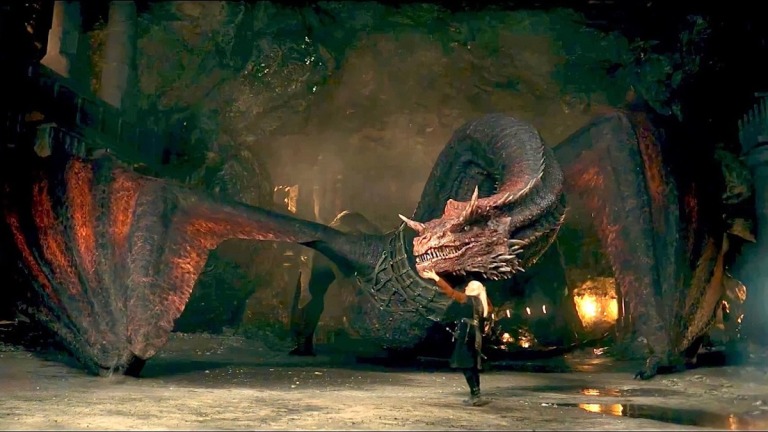
That’s not to say this is always going to be the case. I’m one of these people who isn’t convinced the streamers will be able to keep these budgets up. The reason they’re doing it now is because they’re trying to establish dominance in the fast-growing industry of streaming. But once the music stops and we know where everyone’s sitting, I think they’re going to start pulling back. They have to. There’s no way they can keep this insane spending up.
In the meantime, what are you going to watch? A movie (The Invitation) that stars the 11th most important character in the Fast and Furious franchise? Or a Star Wars show? I think the answer is obvious.
It’s yet another reminder that CONCEPT IS KING – something I was just talking about Thursday. When you’re coming up with movie ideas, you have to think like that guy who’s sitting there on a Thursday night, who may or may not want to go to the movies this weekend. He’s leaning towards not going cause there isn’t a new Marvel movie out. What are you giving that person that will make him want to go? It’s got to be a big juicy idea. Which reminds me, High Concept Showdown is coming people! So get those scripts ready.
What: AMATEUR SHOWDOWN – HIGH CONCEPT EDITION
When: Entries due December 1 by 8pm Pacific Time
How: E-mail me your title, genre, logline, any extra pitch you want to make about why your script deserves a shot, and, of course, a PDF of the screenplay.
Where: carsonreeves3@gmail.com
Anything else?: You can start sending in your scripts right now!
One minor story I caught from this weekend was the showings of two former, “WHAT THE HELL DID I JUST READ” script reviews. Bodies Bodies Bodies and Vengeance. I was shocked to find that both movies received relatively strong critical scores (Vengeance at 79% and Bodies Bodies Bodies at 86%). Cause I thought these scripts were beyond awful. Bodies Bodies bodies was a glorified game of drunken hide and seek. And Vengeance had one of the most despicable unlikable protagonists I’ve come across in a long time.
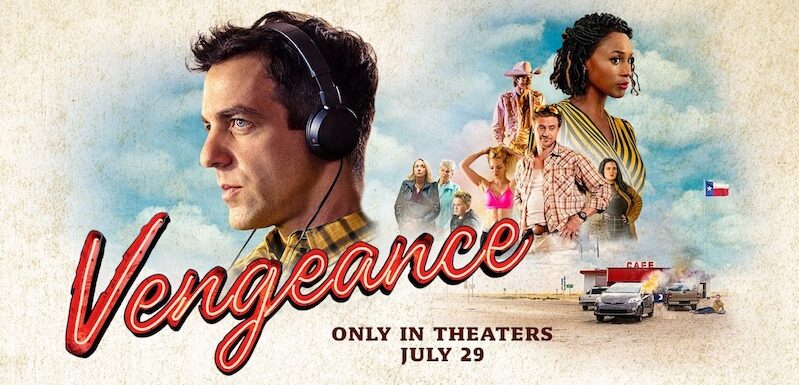
Why are these movies working for people? I don’t know for sure because I haven’t seen them yet, lol. But I do know that when the writer is also the director, there are two things you can drastically change about a script. The first is the stylistic look of your movie. Bodies Bodies Bodies looks a lot more stylistic than I imagined it would be. Which definitely helps give it its own identity.
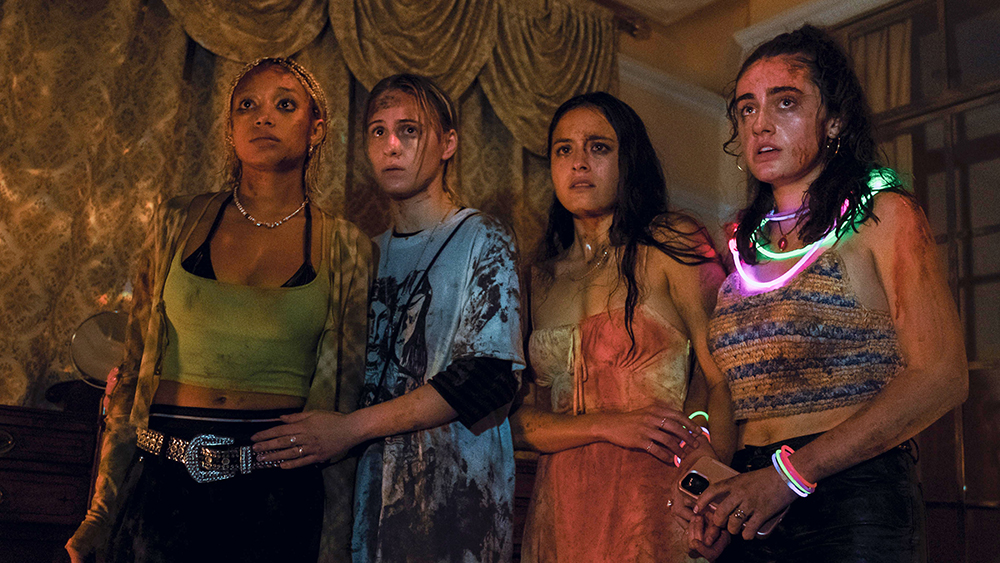
The other big thing you can do is soften the look and feel of a character onscreen who, on paper, was a big fat jerk. You can do this through casting. Or, in B.J. Novak’s case (who was the writer, director, and star), you simply play the character a lot nicer. And it looks like that’s what he did to offset how unlikable that character was on the page.
I’m all about admitting when I’m wrong about a script. I think it’s important for all screenwriters to understand why something works even if they, themselves, hate it. And I believe that’s what happened here. Although I’m curious, for those of you who saw the films, what did you think of them? Should I give them a shot? Or was my original analysis correct and they’re both benefactors of the current critical trend of propping movies up more for what they and the creators symbolize than how good they are?
Let me know in the comments.
And, oh yeah, a new newsletter is coming this week! Watch out for it in your inbox. I review one of the wilder premises I’ve ever seen for a big-budget film. I’ll be including a link to the script so you can check it out yourself (e-mail carsonreeves1@gmail.com if you want to be on the list).


